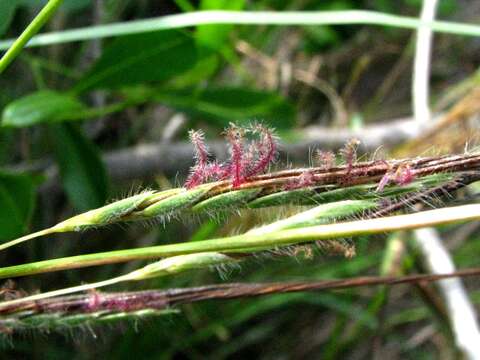Heteropogon contortus

Descrição:
Pili or Twisted beardgrassPoaceae (Gramineae)Possibly indigenous to the Hawaiian IslandsOahu (Cultivated)Pili flowers in photoSeedswww.flickr.com/photos/dweickhoff/5187441025/in/photolist-...Habitwww.flickr.com/photos/dweickhoff/5187439999/in/photolist-...The Hawaiian name pili means "to cling or stick."Early Hawaiians made a black dye was made from the charcoaled leaf blades.Whether indigenous or a Polynesian introduction, early Hawaiians used pili as their first choice for thatching roofs and for its brown color, neat appearance, and pleasant odor. Pili was harvested by uprooting a bunch. The soil, roots, and flowering spikes were trimmed and the pili bunch was ready for use. They were tied in rows with stems up, placed close together and worked from the bottom of the frame upwards. Pili thatch was replaced every four or five years.Medicinally, burned pili and ashes mixed with coconut was used for ea (thrush) and paoao (childhood disease with physical weakening).The leaves were also used by Hawaiians to stuff mattresses, pad floors, and as a tinder.EtymologyThe generic name Heteropogon is derived from the Greek heteros, different, and pogon, beard in reference to the two kinds of spikelets found in the inflorescence of this species.True to the Latin specific epithet contortus, pili seeds have an unusual habit of contorting when wet in order to burrow head into the soil.www.flickr.com/photos/dweickhoff/5187440899/in/photolist-...nativeplants.hawaii.edu/plant/view/Heteropogon_contortus
Incluído nas seguintes páginas:
- Life
- Cellular
- Eukaryota (Eucariontes)
- Archaeplastida
- Chloroplastida
- Streptophyta
- Embryophytes
- Tracheophyta
- Spermatophytes (Spermatophyta)
- Angiosperms
- Monocots
- Commelinids
- Poales
- Poaceae (grama)
- Heteropogon
- Heteropogon contortus
Esta imagem não aparece em nenhuma coleção.
Informação de origem
- licença
- cc-by
- direitos autorais
- David Eickhoff
- fotógrafo
- David Eickhoff
- original
- arquivo de mídia original
- visite a fonte
- site do parceiro
- Flickr Group
- ID


